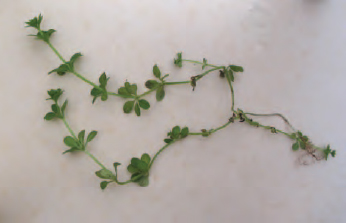The range of weed species includes algae, mosses, liverworts, ferns and
flowering plants. These species display one or more special features
of their life cycle which enable them to compete as successful weeds
against the crop, and cause problems for the horticulturist.
- Ephemeral weeds, such as groundsel and chickweed, produce seeds
through much of the year. Weed seeds often germinate more quickly
than crop seeds and thus emerge from the soil to crowd out the
developing plants. Their seeds germinate throughout the year. Their
roots are often quite shallow.
- Annual weeds, such as speedwells, annual meadow grass and fat hen,
are similar to the ephemerals in their all-year round seed production.
Their seeds take longer to ripen those of ephemerals. They may
develop deeper roots than ephemerals.
- Perennial weeds, such as creeping thistle, couch-grass, yarrow and
docks, have long-lived root system. Each species has an underground
organ that is difficult to control. The creeping thistle has long lateral
roots; couch has long lateral rhizomes; yarrow has long lateral roots
and docks have deep, swollen roots.
Whilst seed production may be high, especially in the last three of
the four above-mentioned species, it is the spreading underground
organs that present the main problems to horticulturalists. The
large quantities of food stored in their vegetative organs enable
these species to emerge quickly from the soil in spring, often from
considerable depths if they have been ploughed in. The fragmentation
of underground organs by cultivation machinery often enables these
species to propagate vegetatively and increase their numbers in
disturbed soils.
Spread of weeds
 |
Figure 13.4 Young cleavers . Seeds on older plants
stick to the fur of animals |
Weeds may be spread in a number of ways:
- fruits such as those in Himalayan balsam discharge seeds explosively
to a considerable distance;
- seeds of species from the Asteraceae family such as groundsel,
thistles, and dandelion, are carried along in the wind
by a seed ‘parachute’;
- seeds of chickweed and dandelion may be spread
by the moving water in ditches;
- fruits of the cleavers weed (see Figure 13.4) stick to clothes and hair of humans and animals in a
manner similar to ‘Velcro’. Chickweed seed is
held in a similar way;
- groundsel and annual meadow grass seeds become sticky in damp conditions and are able to
stick to boots and machinery wheels;
- a proportion of the seeds of groundsel, annual
meadow grass, yarrow and dock survive digestion
in the guts of birds;
- chickweed and annual meadow grass seed is also able to survive mammal digestive systems;
- cut stems of slender speedwell are moved by grass mowers;
- ants carry around the seeds of speedwell;
- underground horizontal roots, stolons and rhizomes of perennial
weeds such as thistle, yarrow and couch respectively slowly spread
the weed from its point of origin;
- ploughs and rotavators move around cut underground fragments of
thistles, yarrow, dandelion, and couch;
- commercial seed stocks can be contaminated with seeds of weeds
such as speedwells and couch.
Other aspects of weed biology
Particular
soil conditions may favour certain weeds. Sheep’s sorrel
(Rumex acetosella) prefers acid conditions. Mosses are found in
badly drained soils. Knapweed
(Centaurea scabiosa) competes well
in dry soils. Common sorrel
(Rumex acetosa) survives well on
phosphate-deficient land. Yorkshire fog grass
(Holcus lanatus) invades poorly fertilized turf. Nettle and chickweed prefer highly
fertile soils.
The growth habit of a weed may influence its success. Chickweed
and slender speedwell produce horizontal (prostrate) stems bearing
numerous leaves that prevent light reaching emergent crop seedlings.
Groundsel and fat hen have an upright habit that competes less for
light in the early period of weed growth. Perennial weeds such as
bindweed, cleavers and nightshades are able to grow alongside and
climb up woody plants, such as cane fruit and border shrubs, making
control difficult.
Annual
seed production may be high in certain species. A scentless
may-weed plant (perennial) may produce 300 000 seeds, fat hen
(annual) 70 000 and groundsel (annual) 1000. A dormancy period is
seen in many weed species. In this way, seed germination commonly
continues over a period of 4 or 5 years after seed dispersal, presenting
the grower with a continual problem. Groundsel is something of an
exception, since many of its seeds germinate in the first year.
Perennial weeds with swollen underground organs provide the
greatest problems to the horticulturist in long-term crops such as soft
fruit and turf because foliage-acting and residual herbicides may have
little effect.
Fragmentation of above-ground parts may be important. A lawnmower
used on turf containing the slender speedwell weed cuts and spreads the
delicate stems that, under damp conditions, establish (like cuttings) in
other parts of the lawn.
Greenhouse production generally suffers less from weed problems
because composts and border soils are regularly sterilized.
Some important horticultural weeds
Specific descriptions of identification, damage, biology and control
measures are given for each weed species. Detailed discussion of
weed control measures (cultural, chemical and legislative) is presented
in
Plant protection.





